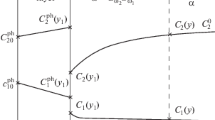Abstract
The initial transient high-temperature oxidation stage for binary alloys forming the most-stable oxide has been examined by means of a numerical procedure based on the finite-difference method. At variance with previous models, the present treatment takes into account the effect of the rate of the reaction at the scale/gas interface over the corrosion kinetics. The calculations concerning the transient stage are developed either using the general parabolic rate law to represent the overall scaling kinetics or using the rate law of the reaction at the scale/gas interface as a boundary condition without imposing any particular rate law to the overall process. A correct analysis of the oxidation behavior of binary alloys during the transient stage must take into account the kinetics effect of the rate of the surface reaction. The concentration of the most-reactive element at the alloy/scale interface changes regularly with time, decreasing gradually from the initial bulk value to its final steady-state value. The present results are in good agreement with those obtained by means of an approximate analytical model developed previously.
Similar content being viewed by others
References
B. Chattopadhyay and G. C. Wood,Oxid. Met. 2, 373 (1970).
D. P. Whittle, D. J. Evans, D. B. Scully, and G. C. Wood,Acta Met. 15, 1421 (1967).
D. P. Whittle, G. C. Wood, D. J. Evans, and D. B. Scully,Acta Met. 15, 1747 (1967).
G. L. Wulf, M. B. McGirr, and G. R. Wallwork,Corros. Sci. 9, 739 (1969).
R. D. Bastow, D. P. Whittle, and G. C. Wood,Oxid. Met. 12, 413 (1978).
F. Gesmundo, Y. Niu, and J. Philibert,Revue de Mét. 1315 (1995).
F. Gesmundo, P. Castello, F. Viani and J. Philbert,Oxid. Met., accepted for publication.
C. Wagner,J. Electrochem. Soc. 99, 369 (1952).
F. Gesmundo, F. Viani, and Y. Niu, Oxid. Met.42, 285 (1994).
C. Wagner,Ber. Bunsenges. Physik. Chem. 70, 775 (1966).
R. Bredesen and P. Kofstad,Oxid. Met. 35, 107 (1991).
J. P. Hirth, B. Pieraggi, and R. A. Rapp,Acta Metall. Mater. 43, 1065 (1995).
P. Kofstad, inHigh Temperature Corrosion, (Elsevier Applied Science, New York, 1988).
J. Philibert, inAtom Movements, Diffusion and Mass Transport in Solids (Les Editions de Physique, Les Ulis, France, 1991).
P. Kofstad, inNonstoichiometry, Diffusion and Electrical Conductivity of Binary Metal Oxides (Krieger Publ. Co., Malabar, Florida, 1983).
Author information
Authors and Affiliations
Rights and permissions
About this article
Cite this article
Gesmundo, F., Pereira, M. The transient state in the oxidation of binary alloys forming the most-stable oxide: A numerical solution. Oxid Met 47, 507–524 (1997). https://doi.org/10.1007/BF02134789
Received:
Revised:
Issue Date:
DOI: https://doi.org/10.1007/BF02134789




